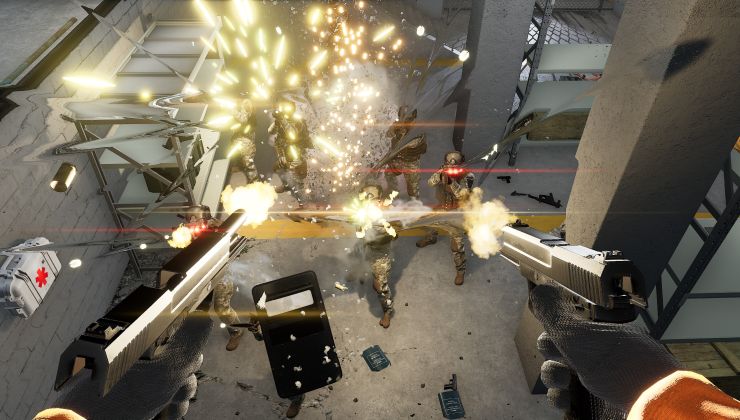Some exciting news for hardware enthusiasts, as Framework just announced today that DeepComputing has made the first partner-developed mainboard with RISC-V.
This RISC-V StarFive JH7110 SoC mainboard will be compatible with the Framework Laptop 13 model, truly showing the power of what modular computing can be for laptops. Here's a shot of it below:
DeepComputing will be showing it off during the RISC-V Summit Europe 2024 between June 24th - 28th in Germany. They noted it's still in early development though, but it's designed to just be an easy quick swap like other modules for the Framework Laptop 13.
From the DeepComputing press release:
“This is just the beginning. This modular RISC-V mainboard showcases our commitment to pioneering open-source hardware solutions that will empower developers and enthusiasts alike.” says Yuning Liang, CEO of DeepComputing.
“There is fantastic philosophical alignment between the Framework and RISC-V communities with a focus on developer and end-user empowerment. We designed the Framework Laptop from the start to enable this kind of architectural flexibility, and we’re excited to see what DeepComputing is creating with the new RISC-V Mainboard.” says Nirav Patel, CEO of Framework.
You can see more in the Framework blog post too which goes over some more details. Linux and open source enthusiasts should keep a close eye on RISC-V with it being an entirely open architecture, so there's no fees involved like with ARM and no gatekeeping like x86-64.
Framework also recently put up open source shell CAD designs for both the Framework Laptop 13 and Framework Laptop 16, so that you can basically do anything with it that Framework said was to enable "unlocking development of cases, skins, and other customization parts".
DeepComputing also recently announced an Ubuntu RISC-V laptop as well, the DC-ROMA laptop II, that features the SpacemiT’s SoC K1.
A very fun time to be following hardware with RISC-V and ARM both taking bigger steps towards more desktop use. The next 10 years certainly will be interesting, looks like we're slowly getting a processor shakeup that's been long overdue.
Last edited by ToddL on 18 Jun 2024 at 6:08 pm UTC
I am slightly interested in RISC-V at least - a laptop-style device could make a good development board. What's the performance and battery life like compared to ARM?
I am slightly interested in RISC-V at least - a laptop-style device could make a good development board. What's the performance and battery life like compared to ARM?
[RISC-V is pretty efficient even when compared to ARM, but that is mostly because it allows you to customize your hardware based on your needs.](https://link.springer.com/article/10.1007/s11227-024-05946-9)
As such it's hard to make a good consumer device out of it.
RISC-V has an even less functional software ecosystem, so it's useless for most consumers.
Although the architecture of RISC-V is open source the firmware isn't yet and some ARM processors do offer open firmware making them more suited for tinkering, because making or manipulating your own chips requires a lot more resources than doing the same with firmware meaning its out of the range of most tinkerers.
The overall results are (as of now; this is a subject to change in time!): "Not great, not terrible".
Overal performance is somewhere around RPi 4B+, maybe a bit above.
My device has different CPU than ROMA II laptop; LicheePi4A uses Alibaba TH1520 RISC-V CPU:
- 4 core @1.85GHz (up to 2GHz, dependant on chip quality)
- vectoring instruction support 0.7.1 (RVV071)
- integrated 5TOPS NPU
- integrated graphics (mobile GPU from Imagination)
- integrated VPU (for hardare video coding/decoding)
These RISC-V solutions suffer from older manufacturing technology (it seems all those Chinese manufacturers are currently stuck at around 12nm manufacturing process, so somewhere at around max. 2GHz clock speeds etc). Good enough for low(er) performance applications (phones, tablets, low-perf laptop/desktops), not good enough for high-performance desktops yet. They will get there in time, though...
Some parts of platform's ISA specifications are still being worked out/added (like hardware virtualization support instruction set).
Also the software/driver support still has to mature: Majority of current RISC-V solutions (Milk-V, StarFive, Sipeed etc., with all their integrated solution boards) are still working to get their drivers to the Linux upstream progressilvely for the past two years (e.g. this LicheePi is currently still stuck on Debian kernel 5.11, kernels 6.x coming soon(tm), also Sipeed's SDK with drivers and 3rd party stuff is required to actually build a bootable kernel/system). Also, the GPU drivers from Imagination are not opensource (yet), despite Imagination's declared goal of opensourcing the drivers (realistically this will take probably years...), so limitted to none desktop/app hardware acceleration availability. Moreover, this (mobile) GPU supports only OpenGL ES, not full OpenGL. Although the GPU does support Vulkan, everything will have to wait for drivers from Imagination...
So despite the platform maturing for the past two-three years, it still has a lot of work ahead. But it will get there in time, it needs a couple of years, maybe. And I'm looking forward to the new open-spec hardware platform
(Also, I'd be very concerned about my future if I was ARM
Last edited by Boldos on 20 Jun 2024 at 8:01 pm UTC
(Disclaimer: Think of RISC-V vectoring instructions specification (or RVV) to be similar to MMX/SSE/AVX instructions from Intel/AMD CPU world).
For the ROMA II laptop, the K1 has double the cores (8x), higher clocks (2GHz) and support for full vectoring instruction standard (RVV10), so it is expected to be much more performant. Still the K1 is a new CPU and I do not thing that - as of now - there are any relevant/consumer performance metrics available (remember, cache/bus/RAM latencies are currently unknown and will also affect overall performance).
Moreover, software/driver support for this brand new K1 platform is an unknown. Here they claim full Ubuntu support which sounds great. It remains to be seen, what exactly that means though...
So on one hand, there are currently lots of performance and sw/driver support unknowns, also the ROMA II laptop for that price seems to be
On the other hand, if they really manage to have full and good sw/driver support (including the GPU, HW accel of destop and full support of VPU on-chip codecs for e.g. high-performance HW decode of video streams) this really could be the first consumer-grade RISC-V machine for bigger masses.
Hopes are high
Last edited by Boldos on 19 Jun 2024 at 5:40 pm UTC
I see no hope in this.
RISC-V has an even less functional software ecosystem, so it's useless for most consumers.
Although the architecture of RISC-V is open source the firmware isn't yet and some ARM processors do offer open firmware making them more suited for tinkering, because making or manipulating your own chips requires a lot more resources than doing the same with firmware meaning its out of the range of most tinkerers.
These devices are exactly what is needed for the software ecosystem to progress. There is only so much a software developper can do without testing his work on an actual device. It's definitely not for the masses yet.
Keep in mind, ARM is over 40 years old (project started in 1983) and x86 was released in 1978 (probably in the work a while before that).
I'm glad that RISC-V continues to make in-roads when it comes to CPU architectures and interested to see where it goes in the future since it's nice to have CPU alternatives besides ARM and x86-64.What would be nice is if there were an affordable PPC as well...
The only affordable PPC is used Macs from way back but it seems like it doesn't get a lot of love from the industry because it's being relegated to servers and not desktop.I'm glad that RISC-V continues to make in-roads when it comes to CPU architectures and interested to see where it goes in the future since it's nice to have CPU alternatives besides ARM and x86-64.What would be nice is if there were an affordable PPC as well...
Yeah, they are sweet processors, but IBM basically has the price locked into 'not for consumers'. I have a few old Macs to run MorphOS on though :)The only affordable PPC is used Macs from way back but it seems like it doesn't get a lot of love from the industry because it's being relegated to servers and not desktop.I'm glad that RISC-V continues to make in-roads when it comes to CPU architectures and interested to see where it goes in the future since it's nice to have CPU alternatives besides ARM and x86-64.What would be nice is if there were an affordable PPC as well...
I see no hope in this.
RISC-V has an even less functional software ecosystem, so it's useless for most consumers.
Although the architecture of RISC-V is open source the firmware isn't yet and some ARM processors do offer open firmware making them more suited for tinkering, because making or manipulating your own chips requires a lot more resources than doing the same with firmware meaning its out of the range of most tinkerers.
These devices are exactly what is needed for the software ecosystem to progress. There is only so much a software developper can do without testing his work on an actual device. It's definitely not for the masses yet.
Keep in mind, ARM is over 40 years old (project started in 1983) and x86 was released in 1978 (probably in the work a while before that).
Yet the masses is where framework shines.
Their laptop aren't particularly open, not particulary fast, but they made laptop modification and repair something anyone can enjoy instead of something you need specialized skills for.
Also developer aimed RISC-V already exist. We at least have the MNT(Pocket) Reform RISC-V version, the MuseBook and the DC Roma RISC-V serie.
It's a young technology with a lot of potential, but the desktop market is slow, demanding and unsuited for the current strengths of RISC-V.
I see no hope in this.Well, to paint a bigger picture here: majority of RISC-V CPUs, boards and complete solutions are coming from China as of now. (China designed, China manufactured)
RISC-V has an even less functional software ecosystem, so it's useless for most consumers.
Although the architecture of RISC-V is open source the firmware isn't yet and some ARM processors do offer open firmware making them more suited for tinkering, because making or manipulating your own chips requires a lot more resources than doing the same with firmware meaning its out of the range of most tinkerers.
You may ask: Why?
Well, one of the (IMHO brutally important) piece of the puzzle here is that RISC-V is an open standard, which is not and cannot be controlled by patents and/or export regulations (The RISC-V foundation moved itselt from US to Switzerland to ensure exactly that). And as a result China is investing huge amounts of money, time, know-how, and general resources, to leverage this tech to achieve at least some level of technological independence in CPU chip tech on "The West". So continuous investment into and development of RISC-V tech is of utmost strategic technological importance to China.
And so, the RISC-V tech train, with China at the wheel, has already departed, China ensures it is gaining speed, and it cannot be stopped, until China reaches it's technological CPU destination. And they don't care what The Rest of The World(tm) thinks of it, because, for once, with this 'patent&export regulation free' tech they don't have to take care of who (dis)agrees....
Thus the question now is not IF the high-performance RISC-V CPUs will arrive to the market, but WHEN. And another question is whether it will be only Chinese chips, or if e.g. US or EU (or anyone else, like e.g. India?) will be able to keep up with China and whether they too will be able to design, produce and sell their own RISC-V CPUs...
Last edited by Boldos on 21 Jun 2024 at 11:35 am UTC
I see no hope in this.Well, to paint a bigger picture here: majority of RISC-V CPUs, boards and complete solutions are coming from China as of now. (China designed, China manufactured)
RISC-V has an even less functional software ecosystem, so it's useless for most consumers.
Although the architecture of RISC-V is open source the firmware isn't yet and some ARM processors do offer open firmware making them more suited for tinkering, because making or manipulating your own chips requires a lot more resources than doing the same with firmware meaning its out of the range of most tinkerers.
You may ask: Why?
Well, one of the (IMHO brutally important) piece of the puzzle here is that RISC-V is an open standard, which is not and cannot be controlled by patents and/or export regulations (The RISC-V foundation moved itselt from US to Switzerland to ensure exactly that). And as a result China is investing huge amounts of money, time, know-how, and general resources, to leverage this tech to achieve at least some level of technological independence in CPU chip tech on "The West". So continuous investment into and development of RISC-V tech is of utmost strategic technological importance to China.
And so, the RISC-V tech train, with China at the wheel, has already departed, China ensures it is gaining speed, and it cannot be stopped, until China reaches it's technological CPU destination. And they don't care what The Rest of The World(tm) thinks of it, because, for once, with this 'patent&export regulation free' tech they don't have to take care of who (dis)agrees....
Thus the question now is not IF the high-performance RISC-V CPUs will arrive to the market, but WHEN. And another question is whether it will be only Chinese chips, or if e.g. US or EU (or anyone else, like e.g. India?) will be able to keep up with China and whether they too will be able to design, produce and sell their own RISC-V CPUs...
Russia is investing heavily as well especially, since it's now under even heavier tech restrictions than China, but
A. you're underestimating the power of technology restrictions and continued development, to be a success it doesn't have to be as good as a decade old iteration of "the west" architectures it has to be superior to the last state of "the west" architectures, those tech restrictions don't serve to keep them in the stone age, but keep them behind,
B. the US and the EU both also invest heavily in chips(just less RISC-V), since its also of strategic importance to them and
C. Although I admit there is hope for RISC-V in general my point was over Framwork RISC-V laptops specifically.
As to why framework won't profit of this
A. future performance is worth something in the software market, because a product bought in the past will be in the future its improved version, but this isn't true for hardware.
B. What makes Framework Framework isn't their openness or dev friendliness, but their ability to turn limited amounts of openness into modularity and make it useful to the less tech savy customer, which is exactly what RISC-V doesn't offer it offers tons of openness, but to change anything about your own version you need a chip manufacturing facility.
C. What makes RISC-V, so good is the freedom to customize it to your needs. In consumer laptops you don't know the needs of your consumer, so you've to make it generic. Eliminating this amazing strength.
Also Risc-V isn't actually patent free or free as in free software, the base architecture is(which is a big improvement), but lots of the innovations which make it competitive aren't.
This doesn't matter to nation states like China and Russia, since patents are easy to ignore for them, but for tinkerers and businesses it matters.
For tinkerers ARM and OpenPOWER(an open "the west" architecture with currently a better software ecosystem than RISC-V, with less nation state backing) are more free, because there are options with fully FOSS firmware(, which is more easily adjustable for people without manufacturing facilities).
For hardware businesses RISC-V and OpenPOWER are more free, because they can afford the remaining patents and the manufacturing facilities.
To software businesses RISC-V is more free, because there is no one foundation/company with power over every iteration and thus can't take their freedom away.
Last edited by LoudTechie on 25 Jun 2024 at 10:53 am UTC
Thus the question now is not IF the high-performance RISC-V CPUs will arrive to the market, but WHEN. And another question is whether it will be only Chinese chips, or if e.g. US or EU (or anyone else, like e.g. India?) will be able to keep up with China and whether they too will be able to design, produce and sell their own RISC-V CPUs...
2023 and yes:
[Venturamicro launched a 4nm 3.6GHZ RISC-V processor in the USA back than.](https://www.ventanamicro.com/ventana-introduces-veyron-v2/)
https://www.reddit.com/r/RISCV/comments/17q0y0t/ventana_veyron_v2_riscv_cpu_launched_for_the_dsa/
Yes, I know about this one. AFAIK it seems it has not been openly released yet, so not available yet to be bought and tested (AFAIK the full release is planned sometime by H2 2024).Thus the question now is not IF the high-performance RISC-V CPUs will arrive to the market, but WHEN. And another question is whether it will be only Chinese chips, or if e.g. US or EU (or anyone else, like e.g. India?) will be able to keep up with China and whether they too will be able to design, produce and sell their own RISC-V CPUs...
2023 and yes:
[Venturamicro launched a 4nm 3.6GHZ RISC-V processor in the USA back than.](https://www.ventanamicro.com/ventana-introduces-veyron-v2/)
https://www.reddit.com/r/RISCV/comments/17q0y0t/ventana_veyron_v2_riscv_cpu_launched_for_the_dsa/
Last edited by Boldos on 25 Jun 2024 at 7:08 pm UTC
Oops, I didn't know that.Yes, I know about this one. AFAIK it seems it has not been openly released yet, so not available yet to be bought and tested (AFAIK the full release is planned sometime by H2 2024).Thus the question now is not IF the high-performance RISC-V CPUs will arrive to the market, but WHEN. And another question is whether it will be only Chinese chips, or if e.g. US or EU (or anyone else, like e.g. India?) will be able to keep up with China and whether they too will be able to design, produce and sell their own RISC-V CPUs...
2023 and yes:
[Venturamicro launched a 4nm 3.6GHZ RISC-V processor in the USA back than.](https://www.ventanamicro.com/ventana-introduces-veyron-v2/)
https://www.reddit.com/r/RISCV/comments/17q0y0t/ventana_veyron_v2_riscv_cpu_launched_for_the_dsa/
Now that I looked again:
From the website I actually get the impression that they won't do a full release and only license their IP and intel connections to companies that want their own custom versions, so we might never get a "full release"










 How to set, change and reset your SteamOS / Steam Deck desktop sudo password
How to set, change and reset your SteamOS / Steam Deck desktop sudo password How to set up Decky Loader on Steam Deck / SteamOS for easy plugins
How to set up Decky Loader on Steam Deck / SteamOS for easy plugins
See more from me